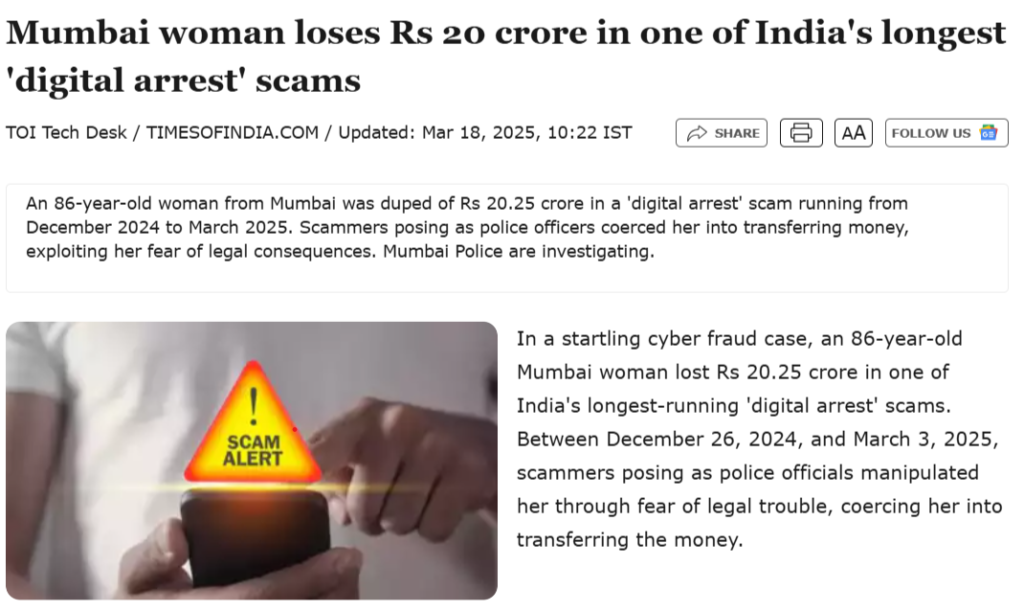Case Study
1. Introduction
In March 2025, an 86-year-old woman from Mumbai became a victim of one of India’s most elaborate cyber scams, losing ₹20.25 crore in a “digital arrest” scam. Fraudsters, impersonating law enforcement officials, manipulated her into believing she was under investigation for money laundering and coerced her into transferring the massive amount over three months.
This case stands as one of India’s largest individual cyber frauds and highlights the growing menace of digital impersonation scams.

2. Background of the Case
The victim, an elderly resident of South Mumbai, was initially contacted in December 2024 by someone claiming to be from the Mumbai Cyber Crime Unit. Over the next three months, she was subjected to:
Continuous psychological manipulation
Threats of arrest for crimes she didn’t commit
Constant video calls with fake law enforcement officials
Instructions to transfer money to “secure her innocence”
The scammers successfully extracted over ₹20 crore, making this one of India’s biggest reported cyber scams in terms of financial loss.
3. Modus Operandi: How the Fraud Was Executed
The digital arrest scam followed a well-planned strategy designed to exploit fear and confusion.
Step 1: Initial Contact & False Allegations
The victim received a call from someone impersonating a law enforcement officer (Cyber Crime Officer).
She was falsely accused of being linked to a money laundering case in Hong Kong.
The scammers displayed fake case files and arrest warrants via video calls.
Step 2: Psychological Pressure & Fear Tactics
The fraudsters pressured her into silence, warning that any disclosure would worsen her situation.
She was forced to communicate exclusively with the fraudsters, cutting her off from family and friends.
The scammers used technical jargon and official-sounding terms to make the fraud more convincing.
Step 3: Financial Exploitation & Money Transfers
The victim was asked to “prove her innocence” by transferring money to a “safe government account”.
Over multiple transactions between December 2024 and March 2025, she transferred ₹20.25 crore to various bank accounts.
By the time she realized it was a scam, the money had been withdrawn or transferred to foreign accounts.
4. Investigation & Law Enforcement Response
How the Case Was Reported
The victim realized she had been defrauded in March 2025.
She contacted her bank, who advised her to report the case to the Mumbai Cyber Crime Cell.
The Mumbai Police immediately launched an investigation into the transactions.
Key Findings from the Investigation
Tracing the Money Trail
- Investigators found that the victim’s money was routed through multiple Indian and international bank accounts.
- A significant portion of the amount was converted into cryptocurrency to avoid tracking.
Use of Fake Identities & IP Masking
- The fraudsters used VPNs and fake caller IDs to pose as Indian law enforcement officials.
- Deepfake technology may have been used to make video calls more convincing.
Crackdown on Fraudulent Accounts
- Law enforcement froze multiple Indian bank accounts linked to the fraud.
- Cyber teams coordinated with Interpol to trace foreign transactions.
Full Report on Mumbai Cyber Investigation: The Indian Express
5. Impact & Lessons Learned
Financial Loss
This is one of India’s biggest individual cyber fraud cases, with ₹20 crore lost.
The chances of full recovery remain low, as much of the money was moved to foreign accounts.
Psychological & Emotional Distress
The elderly victim faced severe trauma, believing she was under real criminal investigation.
Reports suggest she required medical and psychological support after the incident.
Exposing a New Cybercrime Trend
The case highlighted the rise of “digital arrest scams”, where scammers use law enforcement impersonation to extract money.
There has been an increase in such scams targeting senior citizens across India.
6. Preventive Measures: How to Stay Safe from Digital Arrest Scams
Verify Caller Identity
Law enforcement agencies NEVER ask for money over a phone or video call.
If you receive a suspicious call, contact your local police station for verification.
Never Transfer Money to Unknown Accounts
Do not fall for threats of immediate arrest.
Government agencies never demand financial transactions via phone.
Avoid Isolation & Report Suspicious Calls
If someone tells you not to talk to family or police, it is likely a scam.
Always report such incidents immediately to the cybercrime helpline.
Use Official Government Helplines
National Cyber Crime Helpline: 1930
Cyber Crime Portal: cybercrime.gov.in
Government Advisory on Digital Arrest Scams: India’s Cyber Security Warning
7. Conclusion
The Mumbai Digital Arrest Scam is a stark reminder of how cybercriminals are evolving their tactics to exploit fear and trust.
This case exposed the need for better cybersecurity awareness, especially for senior citizens.
It highlights the role of cryptocurrency in cyber fraud and the difficulty of tracing stolen funds.
Authorities must work on strengthening financial tracking mechanisms and public awareness campaigns.
This high-profile fraud emphasizes the importance of education, legal action, and technological advancements in tackling India’s growing cybercrime crisis.